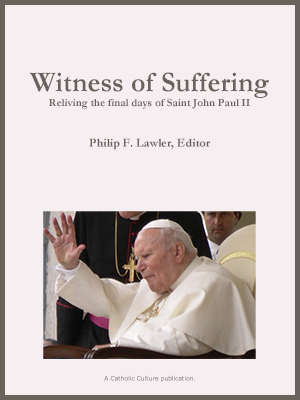Tom Hiney: Raging toward stillness in God
By Dr. Jeff Mirus ( bio - articles - email ) | Aug 30, 2022 | In Reviews
In a remarkable new book from Ignatius Press, Catholic convert Tom Hiney has written his conversion story in an unusual, highly literate, and very special way. In order to capture much of what is significant about his own progress into the Catholic Church, Hiney tells the stories of a variety of remarkable figures who have exemplified in various periods of history aspects of what it takes to commit oneself fully to the Truth of Christ. The book is entitled The Song of Ascents, a reference to the Psalms sung in going up to Jerusalem for the great Jewish religious festivals. The striking subtitle is “Lives of Rage and Stillness”.
Hiney’s account is divided into two parts. The first is “How It Feels to Believe”, in which his reflections on his own life are revealed primarily through the struggles of the following figures:
- Charles Smith, a young ship’s surgeon who experienced and survived a whaling ship trapped for months in northern waters by expanding ice and icebergs in 1866.
- Dr. David Livingston, who missionized (after a fashion) and explored Africa while working to derail the slave trade between 1840 and 1873.
- Samuel Morris, an African prince who converted to Protestant Christianity, with a marked success at evangelization attested by a great variety of miracles, and who spent his life attempting to understand more and more about the Holy Spirit, including a significant visit to the United States in the 1890s.
- Fr. Antoni de Monserrate and the Jesuits from Portuguese Goa who committed themselves to a very difficult evangelization of the Moghul Empire in southern Asia and India under Akbar the Great in the late 1500s.
- The major figures of the Old Testament, in a brief but impressive tour of salvation history as the Jews yearned for and awaited the Messiah.
There follows a postscript to this first part of the book, which neatly wraps up its title theme of “How It Feels to Believe”.
Higher and higher
But for Hiney, the issue is not simply belief in Christ but choosing explicitly to become a Catholic. That is why the second part of The Song of Ascents is entitled “The Logical Catholic”. This part features chapters which further the conversion theme through his reflections on another set of impressive figures:
- Alfred the Great, the Catholic Saxon king who defeated the pagan Viking invaders and established the piety, learning and law which became the very foundation of Catholic England for centuries. This is the same Alfred who is the subject of G. K. Chesterton’s Ballad of the White Horse; he lived from about 848 to 899 AD.
- The inspired Catholics (Cardinal Wyszynski, St. John Paul II, Fr. Jerzy Popieluszko, Lech Walesa, the remarkable composer Henryk Gorecki, and other artists) who against all odds fueled an uprising in Faith to end Communism in Poland within the memory of most of us today.
- The heroic Protestant British General Charles Gordon, who fought with remarkable courage in the strangeness that was the nineteenth-century British Empire, to maintain peace and security, often taking massive reductions in pay in order to be in a trouble-spot where he alone could seemingly do any good.
In the postscript to this second section, Hiney reflects on the life of St. Teresa Benedicta of the Cross (Edith Stein), the atheist Jewish convert to Catholicism who died for both faiths in Auschwitz. She was converted by reading Saint Teresa of Avila’s Autobiography. When she finished the book, she announced: “That is the truth.” Thereafter, she insisted that religion was “not something to be relegated to a quiet corner or for a few festive hours.” It must “be the root and basis of all life: and that, not merely for a few chosen ones, but for every true Christian (though of these there is still but a ‘little flock’).” Of his own Protestant reservations about embracing the Catholic Faith, Hiney comments: “By the time I read those lines, my protest was over.”
Ascended
In an Epilogue, Hiney discusses the life and influence of his father, whose own father had died when he was a child and who was abandoned by his own mother as an orphan. When he learned as an adult that she was still alive and he tracked her down, she wanted nothing to do with him. But by his son’s fascinating account, he was a courageous and adventurous man. Though raised Catholic, he had become an Anglican priest in order to reconcile his desire to marry with his desire to be a priest. This explains how Tom Hiney himself eventually became an Anglican priest. But it turned out that neither remained happy with that decision. As Hiney recounts:
When I told him that I had decided to resign my orders as an Anglican chaplain in order to be received into the Roman Catholic Church, he declared his resolve to follow me. In the end he beat me to it, a bedside occasion that pretty much defines gentleness in my memory…. I could see that he was ready for death, that peace had won the battle for his soul, faith had scored its victory. The last time I visited him, I lay down on the bed next to him and prayed with some rosary beads, and he joined in on the amens. There are a lot of amens in the rosary, and I can still hear his voice, broken by strokes, but resolute: “Amen.” “Amen.” “Amen.” When I kissed him goodbye, he said something I could not catch, so I asked him to repeat it. “Thank you, especially for the prayers.”
Tom Hiney was received into the Catholic Church a few weeks later. He had completed his Song of Ascents to the degree institutionally possible. But what a fascinating way he has chosen to capture the attitudes of soul and personal striving that are so essential to the acceptance of Christ in His Church, and the intense desire to continue to rise until we are risen in Christ. This is a remarkable conversion story for the simple reason that it is not so much a spiritual autobiography as a personally conducted tour through the various aspects of human striving and divine illumination which manifest themselves in so many remarkable lives.
The author once made his living as a journalist, and he was clearly a good one. He has also read extraordinarily widely and well. His accounts of the various figures—the “lives of rage and stillness” in which the purifying work of the Holy Spirit burns—make for an immensely dramatic and entertaining book. Tom Hiney is now preparing for ordination as a Catholic priest. If, as he did, we can discern the hand of God in all of these accounts which shed light in their own way on his conversion, perhaps we can once again stoke the fire we need to keep warm on our own journey home.
Tom Hiney, The Song of Ascents: Lives of Rage and Stillness. Ignatius Press, 315pp. $15.26 paper, $11.67 ebook.
All comments are moderated. To lighten our editing burden, only current donors are allowed to Sound Off. If you are a current donor, log in to see the comment form; otherwise please support our work, and Sound Off!
-
Posted by: winnie -
Aug. 31, 2022 9:27 PM ET USA
The sample on Kindle was such a page turner that I just bought the book.
-
Posted by: winnie -
Aug. 31, 2022 11:37 AM ET USA
I love and trust your book reviews. Just ordered a Kindle sample.
-
Posted by: grateful1 -
Aug. 30, 2022 7:07 PM ET USA
A lovely review of what appears to be a truly moving book. Thanks, Jeff.








